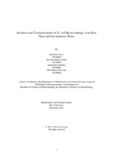| dc.contributor.advisor | Naser, Iftekhar Bin | |
| dc.contributor.author | Islam, Mahbuba | |
| dc.contributor.author | Siddik, Md Abu Bakar | |
| dc.contributor.author | Mondol, Sudorshon | |
| dc.contributor.author | Hossain, Md Shahriar | |
| dc.date.accessioned | 2024-03-11T04:19:36Z | |
| dc.date.available | 2024-03-11T04:19:36Z | |
| dc.date.copyright | 2023 | |
| dc.date.issued | 2023-12 | |
| dc.identifier.other | ID: 19126033 | |
| dc.identifier.other | ID: 19136058 | |
| dc.identifier.other | ID: 19136061 | |
| dc.identifier.other | ID: 19136045 | |
| dc.identifier.uri | http://hdl.handle.net/10361/22482 | |
| dc.description | This thesis is submitted in partial fulfillment of the requirements for the degree of Bachelor of Science in Biotechnology and Bachelor of Science in Microbiology, 2023. | en_US |
| dc.description | Catalogued from PDF version of thesis. | |
| dc.description | Includes bibliographical references (pages 62-65). | |
| dc.description.abstract | Several diseases such as stomach cramps, urinary tract infections, and diarrhea are caused by the bacterium Escherichia coli. One of the five subtypes of E. coli which are ETEC, EPEC, EAEC, EHEC/STEC, and EIEC are responsible for intestinal infections. E. coli outbreak is a major public health concern. One of the key elements that can put an end to outbreaks could be bacteriophages. Since their discovery in 1915, they have been beneficial to humans in a variety of ways, including phage therapy, genetic screening tools, diagnostic weaponry, pathogenic bacteria detectors, therapeutic agents, and more. Phage research has gained attention because of the recent rise in antibiotic resistance because of their capacity to infect and destroy bacteria without endangering humans. This experiment is designed to isolate and characterize bacteriophage specific to E. coli. It includes procedures that have been used in the lab to check for the presence of phages and the results of the experiments. In this research, E. coli bacteria and bacteriophage was isolated from the Raw meat. Unfortunately, only one bacteriophage was possible to isolate from Raw meat and which is why water samples are collected from various regions of Mohakhali, Gulshan and Hatirjheel and from the samples, four more bacteriophages were successfully isolated. Phage ECPW4.4, ECPW5.1 and ECPW12.3 were chosen for further analysis and characterization. In characterization, three tests were done, which were; Temperature test, salinity test and pH test. On these three tests, the three bacteriophages showed better results overall. Furthermore, more tests and analysis are needed to be done but because of the closure of BRAC University Lab, further research was not possible. | en_US |
| dc.description.statementofresponsibility | Mahbuba Islam | |
| dc.description.statementofresponsibility | Md Abu Bakar Siddik | |
| dc.description.statementofresponsibility | Sudorshon Mondol | |
| dc.description.statementofresponsibility | Md Shahriar Hossain | |
| dc.format.extent | 65 pages | |
| dc.language.iso | en | en_US |
| dc.publisher | Brac University | en_US |
| dc.rights | Brac University theses are protected by copyright. They may be viewed from this source for any purpose, but reproduction or distribution in any format is prohibited without written permission. | |
| dc.subject | Bacteriophage | en_US |
| dc.subject | Phage | en_US |
| dc.subject | Phage isolation | en_US |
| dc.subject | Phage characterization | en_US |
| dc.subject | Phage therapy | en_US |
| dc.subject.lcsh | Sewage--Microbiology. | |
| dc.title | Isolation and Characterization of E. coli Bacteriophage from Raw Meat and Environment Water | en_US |
| dc.type | Thesis | en_US |
| dc.contributor.department | Department of Mathematics and Natural Sciences, Brac University | |
| dc.description.degree | B. Microbiology | |

